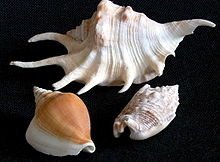Stromboidea
| Stromboidea | |
|---|---|
 |
|
| Three shells of species in the Stromboidea | |
| Scientific classification | |
| Kingdom: | Animalia |
| Phylum: | Mollusca |
| Class: | Gastropoda |
| (unranked): | clade Caenogastropoda clade Hypsogastropoda clade Littorinimorpha |
| Superfamily: |
Stromboidea Rafinesque, 1815 |
| Families | |
|
See text |
|
See text
The Stromboidea, originally named the Strombacea by Rafinesque in 1815, is a superfamily of medium-sized to very large sea snails in the clade Littorinimorpha.
Stromboideans have medium to large shells, attaining a wide variety of lengths depending on the species (20–400 mm from the smallest aporrhaids to the largest strombids). A stromboidean shell has a medium (e.g. spider conchs, Lambis spp.) to high spire (e.g. tibias, Tibia spp.), and a thickened and frequently expanded outer lip (e.g. the queen conch, Lobatus gigas, or the goliath conch, Lobatus goliath) that may be ornamented by long spines (e.g. the spider conch, Lambis chiragra, common pelican foot, Aporrhais spp.) or digitations (e.g. the millipede spider conch, Lambis millepeda). The anterior portion of the outer lip may present a stromboid notch, an indentation through which one of the animal's long eyestalks may protrude.
The shell morphology of some stromboideans (e.g. Lobatus gigas) is not solely determined by the animal's genes; environmental conditions such as location, diet, temperature and depth, and biological interactions such as predation, can greatly affect it. Juvenile individuals of some species develop heavier shells when exposed to predators. They also develop wider and thicker shells with fewer but longer spines in deeper water.
This superfamily was previously known as Strombacea. Prior to the recent ruling by the ICZN, many invertebrate superfamily names ended in the suffix -acea, or -aceae, not -oidea as now required according to ICZN article 29.2. The suffix -oidea used to be used for some subclasses and superorders, where it is still found. In much of the older literature including Keen 1958, Moore and colleagues 1952, and the Treatise on Invertebrate Paleontology, gastropod superfamilies are written with the suffix -acea.
...
Wikipedia
